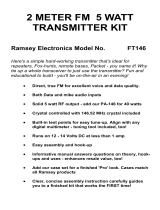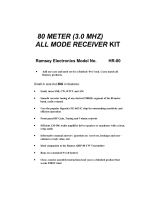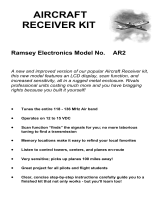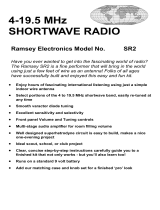Page is loading ...

©1995 Hamtronics, Inc.; Hilton NY; USA. All rights reserved. Hamtronics is a registered trademark. Revised:
11/27/07
-
Page
1
-
SCOPE.
This manual applies to units made
after Nov 2007.
FUNCTIONAL DESCRIPTION.
The CC432 is a low-noise receiving
converter designed, in several models
with variations in tuned circuits, to
convert signals in the uhf range to an
i-f frequency in the hf or vhf range.
Following is a list of common CC432
Converter models.
Model # Input Range Output
Range
CC432-2 432-434 28-30
CC432-5 435-437 28-30
CC432-3 435.5-437.5 28-30
CC432-4 432-436 144-148
CC432-9 439.25 ATV 61.25 (Ch 3)
The converter is available in three
configurations: pc board kit with case
and BNC jacks, pc board kit less case
(RCA jacks on board), and wired and
tested unit in case with BNC jacks.
THEORY OF OPERATION.
The circuit for the converter is
relatively simple. A GaAsFET rf am-
plifier is coupled to a mos fet mixer
through a triple-tuned circuit for se-
lectivity. An overcoupled double-
tuned mixer output tank circuit is
used to achieve a wide bandwidth.
Oscillator Q3 uses fundamental
crystals in the 14-16 MHz range for
easy frequency trimming. The collec-
tor circuit is tuned to the third har-
monic of the crystal frequency, about
42-48 MHz. Q4 triples this frequency
again to about 126-144 MHz. Then,
Q5 either triples this again to the 378-
407 MHz range, or in the case of the
two-meter output model, it doubles to
about 288 MHz. Double-tuned cir-
cuits are used throughout the multi-
plier/injection chain for signal purity.
Following is a summary of the fre-
quency scheme for each model.
Model Injection Xtal Freq.
CC432-2 404 14.962962
CC432-5 407 15.074074
CC432-3 407.5 15.092592
CC432-9 378 14.000000
CC432-4 288 16.000000
CONSTRUCTION.
Note that uhf equipment requires
precise construction using short, di-
rect leads. Seat parts as close to the
board as possible without over-
stressing the leads.
Be sure to follow instructions as
given and don't arbitrarily do things
differently. Refer to the component
location diagram and parts list during
assembly.
CAUTION
CAUTIONCAUTION
CAUTION: The chip capacitors are
very small and easy to damage, mix
up, or lose. Leave them in the plastic
carrier strips until time to install.
CAUTION
CAUTIONCAUTION
CAUTION: Static handling precau-
tions are required for the fet's. The
small geometry and high impedances
make FET's heat and static sensitive;
so be careful. It is good to discharge
your hand to a grounded metal object
just before picking up a transistor,
and the use of a grounded soldering
iron is mandatory. A heat sink is not
necessary while soldering if you are
careful to apply no more heat than
necessary.
Do not be overly anxious about
blowing out the fet's if you observe
these precautions. The transistors are
all factory tested and wrapped in foil
to ensure that they arrive in good
condition. There is no warranty cov-
erage for damage which occurs in
construction or handling; but re-
placement transistors are moderately
priced.
------------------------
a. Set board on bench or in hold-
ing jig oriented as shown.
b. Begin by tack soldering the two
FET's (Q1 & Q2) to the foil on the top
of the pc board. Orient the drain
(long) leads as shown. Lettering on the
transistors should be up. (See detail at
the left side of the diagram.) Carefully
bend the leads at right angles toward
the bottom of the FET's, and install
them in the four holes for each tran-
sistor. Solder the pads under the
board.
c. Install the six small variable ce-
ramic capacitors and the one piston
variable capacitor, orienting them as
shown. See parts list for values.
d. Install chip capacitors and re-
sistors on top of board as follows. Use
small tweezers to handle them. Be
careful not to drop them, because
they are difficult to find. Since they
have no markings, be sure to leave
them in the package until installed so
you can tell the values apart. Refer to
parts list for values. (Additional chip
parts will be installed on the bottom of
the board later.)
Note where capacitors and resis-
tors are to be positioned. They must
straddle the area between a pad on
the board and the ground plane, with
one electrode soldered to each. Do all
of one value at a time; then start the
next value of capacitor, and so on un-
til done.
Apply a little solder to the pads
where one end of each capacitor will
be positioned. Do not apply solder to
the ground plane yet, just the pads
isolated from the ground plane. (You
can pretin the isolated pads for all of
the chip capacitors and resistors now,
but install only one value at a time.)
Pick up one part at a time, re-
moving it carefully from its carrier
strip by peeling back the tape with a
knife or diagonal cutters. Set the part
in place. Then heat the solder on the
pc board pad, and allow the solder to
bond to the electrode on the part.
When the solder melts, the part will
seat down on the board in the molten
solder. (It is essential that this proc-
ess be done relatively quickly so the
solder doesn't oxidize and so there is
still a little flux left where the capaci-
tor electrode sits.)
After one end of each of the parts
is soldered and the positions have
been confirmed to be correct, solder
the other end of each part to the
ground plane. Repeat for other values
of chip capacitors and resistors.
e. In like manner, solder chip re-
sistor R2 on the bottom of the board
as indicated in the detail view to the
right of the diagram. Solder other
chip parts on bottom of board as indi-
cated in parts list.
f. If RCA jacks are to be used (no
case), install them on the board. Ori-
ent them with the center conductor
tab toward the circuitry on the board,
rather than toward the edge of the
board. Solder ground tabs to ground
plane on top of board, and solder cen-
ter contacts under board. If the pc
board will be installed in a case, the
RCA jacks will not be used; in this
case, tack solder a 1" length of #20
bus wire to the pad for the center
conductor of each of the jack posi-
tions, bringing the free end of the wire
out the top of the hole to be connected
later to the BNC jack, as shown in the
diagram.
g. Tack solder the shield in place
between Q1 and L2 as shown. The
front of the shield should be flush
with the front edge of the board. Cut
top corners of the shield on a 45° an-
gle just a little to remove sharp edges.
HAMTRONICS
®
CC432 UHF RECEIVING CONVERTER
ASSEMBLY, INSTALLATION, OPERATION, AND MAINTENANCE

©1995 Hamtronics, Inc.; Hilton NY; USA. All rights reserved. Hamtronics is a registered trademark. Revised:
11/27/07
-
Page
2
-
h. Install all disc and monolithic
ceramic capacitors with very short
leads. Install electrolytic capacitor
C16, observing polarity.
i. Install all resistors. They are
mounted vertically; be sure to orient
the body of the resistor as shown by
large circles in parts location diagram.
Leave the top leads of R12 and R14
about 1/8" high to act as test points.
(See detail.)
j. Install transistors Q3-Q5 and
voltage regulator ic U1, orienting as
shown and using short leads.
k. Install ferrite beads Z1-Z5,
and solder leads to board. The beads
are already strung on bus wire.
l. Wind coils L1-L4 and L11-
L12 with #20 bus wire on 1/8 inch
diameter drill bit shank, and then in-
stall them on the board. Be sure to
wind them in the direction shown so
coils are oriented as indicated. Leave
the bottom of each coil 1/16 inch
above the ground plane. After solder-
ing, space the turns neatly to fill
space between pads on the board. L4,
especially, must be spaced out con-
siderably between turns, as shown in
diagram.
m. Install slug tuned coils as
shown, and install coil shields. The 2-
1/2 turn (red) coils come with shields
already on the coils; however, in some
cases, the shield must be removed
and rotated 90° in order to fit holes in
pc board. The 6-1/2 turn (blue) coils
and other coils have shields supplied
separately.
The shorter coils used for L5 and
L6 require slugs to be installed. Be
sure that you have a properly fitting
tuning tool, e.g. our model A28 Tun-
ing Tool; if the tool slips in the slot, it
will fracture the tuning slug. Note
that the shields for L5 and L6 will
have their bottoms up off the board
slightly; this is normal due to the
height of the coil form.
Make sure the coils and shields
are fully seated, and solder both
shield lugs. (Do not bend lugs over,
but you can bend the coil leads over a
little to hold them in place while sol-
dering.)
n. Install crystal Y1. Insert leads
through board and solder, using care
not to apply excessive heat. Normal
soldering heat is OK, but avoid "cook-
ing" the crystal by heating pads for
excessive periods of time. Allow a tiny
bit of space between the crystal and
the pc board to avoid having the metal
base short to the pads for the leads.
o. Check over all parts and solder
connections. If any parts are missing,
see if you have other parts left over.
You may have installed a wrong value
somewhere; so recheck all values
looking for the missing parts. Color
codes and printed numbers are diffi-
cult to read on many small parts, so
care is sometimes needed to avoid
mixups.
CASE ASSEMBLY.
If the converter was purchased
with case, perform these additional
steps.
a. Set lower half of case on bench,
oriented as shown.
b. Fasten one angle nut to hole
half way back on each side, between
the two pc board mtg holes shown in
diagram. (See detail.) Insert 4-40 x
1/4" screw from bottom of case; then
install angle nut from top of case. The
leg with the longer dimension from the
bend to the hole goes over the screw,
leaving the side with the shorter di-
mension for the cover screws to en-
gage. Before tightening the screws,
carefully align the angle nuts flush
with the edge of the chassis.
c. Install pc board in case oriented
as shown, using eight 4-40 x 1/4"
screws and four threaded standoffs.
Attach standoffs to case first, and
then fasten board to standoffs.
d. Install the two BNC jacks as
shown. Put connector through hole;
and secure with lockwasher, ground
lug, and nut. Orient ground lugs as
shown, and bend them at right angles
as close to nut as possible for direct
ground path.
e. Install feedthrough terminal
from front of case, and secure with
mating nut.
f. Solder a short length of bus wire
from the feedthru to B+ terminal pad
E1 on the pc board.
g. Solder short pieces of #20 bus
wire (left over from L1 & L2) between
the BNC ground lugs and the pc
board ground plane directly adjacent
to lugs (shortest possible path).
h. When the pc board was assem-
bled, bus wire leads were attached to
the pc pads normally used for the
RCA jacks on the board. Tack solder
these leads to respective BNC jack
center conductors, using most direct
route.
i. Remove backing paper from the
rubber feet, and stick one in each
corner on the bottom of the case,
about 1/2 inch in from each edge of
the case.
j. This completes assembly. After
alignment, slide top cover over case,
and secure with one 4-40 screw in
each side of the cover.
CRYSTALS.
Crystals are standard HC-25/u,
fundamental, 32pf, parallel resonant
units with .001% grinding tolerance.
The crystal frequency normally falls in
the 14-16 MHz range. The parts list
gives frequencies of crystals for com-
mon models. In general, the following
formulas apply.
For most models,
For most models,For most models,
For most models, those with an i-f
output in the 28-62 MHz range, the
multiplier is 27; so,
crystal freq = (input - output)/27.
For the CC432
For the CC432For the CC432
For the CC432-
--
-4 model,
4 model,4 model,
4 model, with an i-
f output in the 144-148 MHz range,
the multiplier is 18 instead of 27; so,
crystal freq = (input - output)/18.
We stock common crystals and will
gladly order special ones for you. If
you order directly from a crystal lab,
make sure you order commercial-
grade crystals, and be sure to give
them complete specs.
Crystals may be supplied in either
HC-49/u holder (solid pins) or HC-
50/u (wire leads). Either type is sol-
dered to the board, using care not to
apply excessive heat. Normal solder-
ing heat is OK, but avoid "cooking" the
crystal by heating pads for excessive
periods of time. Allow a tiny bit of
space between the crystal and the pc
board to avoid having the metal base
short to the pads for the leads.
ALIGNMENT.
Equipment needed for alignment is
a 12 to 14 Vdc regulated power sup-
ply, a sensitive dc voltmeter, and a
stable signal generator or strong on-
the-air signal. If you use a tunable
signal generator, warm it up long
enough to assure stability.
The tuning slugs in the coils require
a .060 inch square tuning tool. We of-
fer the A28 tool in our catalog. Be
careful not to attempt tuning with a
makeshift tool, which would likely
crack the slugs and make them seize
up.
a. Preset all variable capacitors
and tuning slugs to midrange. Ca-
pacitors are at maximum capacitance
from the factory; so turn each rotor
90°. Note that it is ok for tuning slugs
to extend partially above the top of
coils.
b. Connect dc voltmeter, set to low
dc range, to TP1 (hot lead of R12).
Adjust L7 and L8 alternately for
maximum on the meter. (It may be
necessary to try different combina-
tions of the two coils to get initial indi-
cation.) Expected voltage is roughly in
the 1 to 2.5Vdc range; the exact volt-

©1995 Hamtronics, Inc.; Hilton NY; USA. All rights reserved. Hamtronics is a registered trademark. Revised:
11/27/07
-
Page
3
-
age is unimportant.
c. Connect meter to TP2 (hot lead
of R14). Adjust L9 and L10 alter-
nately for maximum response. Re-
move meter. Expected voltage is
roughly in the 0.4 to 1Vdc range; the
exact voltage is unimportant.
d. Apply strong input signal at the
center of the band to be used, and
monitor S-meter on receiver.
e. Alternately peak the following
variable capacitors for maximum sig-
nal strength: C34/C35 in the last
multiplier stage, C5/C7/C8 at the
mixer input, and C2 at the rf amplifier
input. Go through a few times and
work out any interactions between ad-
justments. Note that C2 tuning will
be relatively broad.
f. Peak L5 and L6 for maximum
signal strength.
g. To adjust the oscillator fre-
quency precisely, put in a signal on
the exact frequency desired and ad-
just piston trimmer capacitor C18 for
"on-frequency" response by what ever
means you can measure frequency er-
ror. If you don't have a way of judging
frequency error on your receiver (bfo,
etc.), you can check the oscillator fre-
quency with a frequency counter at
TP1. (If your crystal is just a little too
far out to net this way, you can try
changing C19 a little to compensate.)
INSTALLATION.
Installation depends on the type of
converter ordered. Connect J1 to the
uhf antenna and J2 to the input of
the receiver used for listening. RCA
plugs are used for boards without a
case. BNC plugs are used for units
supplied with a case. Always use best
quality low-loss coax at uhf frequen-
cies.
The power terminal on the pc
board or the feedthrough terminal on
the front of the case should be sol-
dered to a source of +12 to +14 Vdc,
preferably a regulated power supply.
Be sure that the same power sup-
ply is not connected to any devices
which could produce damaging volt-
age transients, for example, motors or
relay coils. Reverse diodes should be
used across such devices to limit
transient pulses. The converter draws
about 25 mA.
TROUBLESHOOTING.
The usual techniques of checking
dc voltages at transistor terminals and
tracing oscillator injection signals with
an rf probe and vtvm are appropriate
for this converter.
A dc voltage chart is given to indi-
cate typical voltages. The measured
voltages may vary from unit to unit
and with different meter types be-
cause of loading and the presense of
rf; so use the information only as a
general guide.
Current drain of the converter,
typically about 25 mA, is also a good
indication of any problems on the B+
line.
Gain of the converter is about 18-
20 dB. Sensitivity when connected to
a typical 10 meter receiver is about
0.2 uV for 12 dB sinad.
When troubleshooting a unit which
has just been built, be sure to check
for solder splashes, bad solder joints,
parts mixed up, etc. It is easy to have
something like that happen during
construction.
Following are approximate positive dc
voltages with respect to ground measured
with an fet vm on a sample unit operating
on 13.6 Vdc.
XSTR Emitter Base Collector
Q3* 4.0 4.3 8.0
Q3** 3.3 4.0 8.0
Q4 2.0 0 8.0
Q5 0.6 0 8.0
* Crystal present.
** Crystal pulled out or oscillator signal
otherwise absent
XSTR Source G1 G2 Drain
Q1 0 0 4 8.0
Q2 0.5 to 1 0 4 8.0

©1995 Hamtronics, Inc.; Hilton NY; USA. All rights reserved. Hamtronics is a registered trademark. Revised:
11/27/07
-
Page
4
-
PARTS LIST.
Note:
♦ means see end of list for different
values for models other than 28-30
MHz i-f.
* R9 and R10 each use two 6.8K re-
sistors tack soldered together at the
top to give 14K total resistance.
** Note: disc cap is no longer avail-
able. Carefully tack solder surface
mount capacitor on bottom of board.
Hold it carefully with tweezers to avoid
dropping it.
Ref Desig Description (marking)
C1 2 pf disc
C2 4.5 pf var cap (white)
C3 100 pf 805 chip
C4 .01 uf 1206 chip**
C5 4.5 pf var cap (white)
C6 100 pf 805 chip
C7-C8 4.5 pf var cap (white)
C9-C11 .01 uf 1206 chip
C12 ♦ 150 pf 1206 chip cap**
C13 ♦ 11 pf disc
C14 ♦ 150 pf 1206 chip cap**
C15 ♦ 680 pf disc (681)
C16 0.47 uf electrolytic
C17 .01 uf 1206 chip
C18 11 pf piston trimmer
C19 43 pf disc
C20-C21 150 pf 1206 chip cap**
C22 .01 uf disc (103)
C23 68 pf disc
C24 1 pf disc
C25 68 pf disc
C26-C27 680pf disc (681)
C28 ♦ 18 pf disc
C29 0.5 pf 805 chip cap **
C30 ♦ 39 pf disc
C31 ♦ 47 pf disc
C32 100 pf 805 chip
C33 30 pf disc
C34-C35 4.5 pf var cap (white)
J1-J2 RCA or BNC jack
JMP-1 Jumper (#20 bus wire)
L1 1¾ T #20 bus wire
on 1/8" i.d.
(see text for details on
all air-wound coils)
L2 2¾T #20 bus wire on
1/8" i.d.
L3 3¾T #20 bus wire
on 1/8" i.d.
L4 2¾T #20 bus wire
on 1/8" i.d.
L5-L6 ♦ 7½T slug-tuned coil,
loose-wound (violet)
L7-L8 6½T slug-tuned coil,
space-wound (blue)
L9-L10 2½T slug-tuned coil,
space-wound (red)
L11 ♦ 2¾T #20 bus wire
on 1/8" i.d.
L12 ♦ 3¾T #20 bus wire
on 1/8" i.d.
Q1-Q2 3SK174 gasfet
(static sensitive!)
Q3-Q4 2N5770
Q5 PN5179
R1 200Ω 1206 chip res
R2-R3 68K 805 chip res
R4 680Ω 805 chip res
R5-R6 100K
R7 200Ω 1206 chip res
R8 1K carbon film
R9-R10* 14K carbon film
R11 2.2K carbon film
R12 680Ω carbon film
R13 3.3K carbon film
R14 1K carbon film
U1 78L08 voltage regulator
Y1 Crystal, see text:
Model Xtal Freq.
CC432-2 14.962962
CC432-5 15.074074
CC432-3 15.092592
CC432-9 14.000000
CC432-4 16.000000
Z1-Z5 Ferrite beads
--------------------------------------------------
♦ Note: Following are different
values used for CC432-9 (439.25-
61.25 MHz):
C12 30 pf disc
C13 0.5 pf disc
C14 43 pf disc
C15 150 pf disc
--------------------------------------------------
♦ Note: Following are different
values used for CC432-4 (432-144
MHz):
C12 15 pf disc
C13 0.5 pf disc
C14 20 pf disc
C15 62 pf disc
C28 15 pf disc
C30 33 pf disc
C31 39 pf disc
L5-L6 2-1/2 turns space-
wound (red)
L11 4-3/4 turns on 1/8" i.d.
L12 5-3/4 turns on 1/8" i.d.

©1995 Hamtronics, Inc.; Hilton NY; USA. All rights reserved. Hamtronics is a registered trademark. Revised:
11/27/07
-
Page
5
-

©1995 Hamtronics, Inc.; Hilton NY; USA. All rights reserved. Hamtronics is a registered trademark. Revised:
11/27/07
-
Page
6
-

©1995 Hamtronics, Inc.; Hilton NY; USA. All rights reserved. Hamtronics is a registered trademark. Revised:
11/27/07
-
Page
7
-
CHIP PARTS FOR CONSTRUCTION OF CC432 UHF CONVERTER:
(includes extras in case you drop one)
5ea 150pf 1206 cap
6 ea .01uf 1206 cap
2 ea 0.5pf 805 cap
4 ea 100pf 805 cap
3 ea 200Ω
ΩΩ
Ω 1206 res
2 ea 680Ω
ΩΩ
Ω 805 res
3 ea 68k 805 res
/





